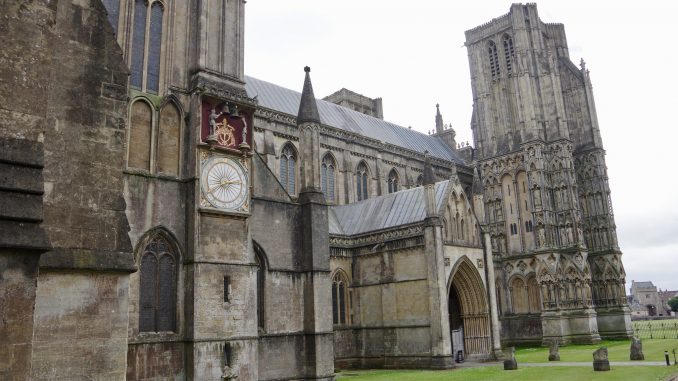
Built between 1386 and 1392, the Wells Cathedral Clock is unique for its distinct two faces, one inside the cathedral, and one outside. The two dramatically different faces were constructed roughly 70 years apart (the interior clock face is older) and are both operated by the same mechanism.
Even though the clock is more than 600 years old, it is actually only the second oldest clock in Britain and missed being the oldest by just a few years since the Salisbury Cathedral Clock was built in 1386. One of the few famous 14th to 16th century astronomical clocks to be found in the West of England, or anywhere in the world for that matter, the Clock at Wells Cathedral is one of the oldest surviving mechanical clocks in the world. And despite not holding the title of the oldest mechanical clock in the country, it does have the distinction of having the oldest surviving clock face in the world so there is something to brag about.
The dial face on the outside at Wells is a fairly traditional 12 hour dial with Roman numerals and two hands. This face was most likely added after the turret movement was installed, and dates to the 14th or 15th century. The reason it is difficult to know the exact date and the range is more than one hundred years is that it was either never recorded, or the records were ironically lost to time. Periodic restoration of almost all parts of the clock also make it near impossible to precisely date when the face was added.

The internal dial face located in one of the Cathedral’s triforium is the more intricately detailed and complex of the two. Featuring a 24 hour dial with two consecutive sequences of Roman numerals I to XII the time keeping is a little more complicated. The hour hand on the internal dial points to the top at midday, indicating the position of the sun overhead.
This astronomical clock offers a geocentric view of the universe with the Earth firmly placed in the center of the universe with the sun and moon rotating around it. Since the clock was built almost 100 years before Copernicus recognized the sun as the center of our solar system, it’s an acceptable oversight.
On this dial, the sun is portrayed on the outer ring as one of the many stars and the moon is on an inner ring where a pointer indicates its phases in a 30 day cycle.
Still in much the same condition it was when it first started counting the hours of the day, the clock at Wells Cathedral strikes every quarter, keeps excellent time, and features jousting knights. The jousting knights chase each other when a figure called Jack Blandifer strikes the bells with his hammer each quarter-hour. Originally designed to joust every hour, the brave display of knighthood was modified to a 15 minute cycle in the 1960s to accommodate tourist interest and ease traffic.
The little bit of time between the construction of the Salisbury and Wells clocks has caused some serious debate (amongst clock nerds) over the years as to which should be honored as the oldest. While it is true that the clock at Salisbury was built first, it was also taken out of service for more than 50 years. Over the course of more than 500 years of service fifty years might not seem like a long time, but to people firmly rooted in the Wells Cathedral corner, it makes all the difference in the world.
To add more fuel to the fire of which clock is technically the oldest, one has to carefully consider what makes a clock a clock. Supporters of Wells have made the argument that the Salisbury clock has no dial or hands, thus does not fit their definition of a clock. And, what is arguably the better argument for the Wells Cathedral clock is that the famous Salisbury was removed from service for nearly fifty years. The Salisbury Cathedral Clock is nonetheless the older of the two and though temporarily out of service, counts the hours of the days now.
For the first 618 years of its life, the Wells Cathedral Clock was wound by hand three times a week by the Keeper of the Great Clock. Since 1919 the Fisher family had the honor of climbing the stairs thrice weekly and cranking each of the three 250kg weights 800 times with an antique iron key in a process that took almost two hours. Paul Fisher, horologist, jeweler, and the final Keeper of the Clock wound the clock by hand for the final time in August of 2010 and promptly retired when the job was finished.
Wells Cathedral Clock Facts
- The now famous clock is so old that it pre-dates the end of the dark ages by more than one hundred years.
- It required 800 winds by hand to hoist each of the three 250 kg (500 pound) weights before the motor-assisted winding system was added in 2010.
- Throughout its life the Wells Cathedral Clock has counted more than 20,000,000,000 seconds. That’s more than 231,000 days.
- In a technical sense, the original movement moved to London’s Science Museum is also one of the world’s oldest clocks but is not listed since it is a single part of another clock.
- The interior and exterior clock faces were constructed roughly 70 years apart (the interior clock face is older).
- Both clock faces are operated by the same mechanism.
- The interior clock face is the oldest surviving original of its kind anywhere in the world.
- There are mentions of a clock at Wells during the latter half of the 14th century, with a payment being made for the keeper of the clock in 1392-1393.
- The original movement for the Wells Cathedral Clock now lives in London’s Science Museum, and is still wound by hand. Technically making it one of the World’s oldest working clocks despite no longer residing in its original location.
- Both faces of the Wells Cathedral Clock are driven by the 19th century (1884) replacement movement.
- The Clock at Wells Cathedral is the second oldest still-in-use clock mechanism in Britain, and likely the world.
- The interior clock face is the oldest surviving original astronomical clock anywhere.
- The Clock at Wells Cathedral and the Salisbury Clock are almost identical in design and construction but Wells has some slight improvements and additions. The changes to the clock mechanism and chime are a strong indication that it was built later.
- The clock was converted to pendulum and anchor escapement in the 17th century. The original mechanism was installed in the Science Museum in London in 1884.


